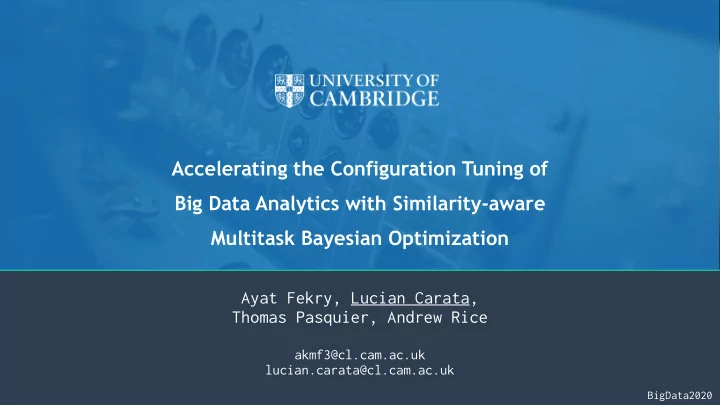

Accelerating the Configuration Tuning of Big Data Analytics with Similarity-aware Multitask Bayesian Optimization Ayat Fekry, Lucian Carata, Thomas Pasquier, Andrew Rice akmf3@cl.cam.ac.uk lucian.carata@cl.cam.ac.uk BigData2020
High-level problem overview ● We want to: – optimize configurations of data processing frameworks (Hadoop, Spark, Flink) in workload-specific ways. – allow amortization of tuning costs in realistic settings: evolving input data (increase in size, ● change of characteristics) an elastic cluster configuration ● 2
High-level problem overview ● We want to: ... Workload Workload Workload optimize execution of workloads in data processing – run on frameworks (Hadoop, Spark, Flink) Big-data processing Data allow amortization of tuning costs in realistic – framework settings: Configuration Execution evolving input data (increase in size, change of ● characteristics) store/ an elastic cluster configuration run on ● load ● When assuming repeated workload execution Cluster daily/weekly/monthly reporting – Instance Type # Instances incremental data analysis Memory – ● Topology Disk (size, bw) ● frequent analytics queries/processing Network (bw) – ● ... ● 3
High-level solution overview ● How: time – By incrementally tuning the W1 W1 W1 configuration of the framework ... Exec 1 Exec 2 Exec n per workload ● determining and tuning only ● Base Tuner (Tuneful) significant parameters ... n Config 1 2 aim is to quickly converge to ● Big-data processing configurations close to optimum framework Configuration Execution metrics 4
High-level solution overview ● How: time – By incrementally tuning the W1 W1 W1 configuration of the framework ... Exec 1 Exec 2 Exec n Similar? per workload ● Wx determining and tuning only ● Similiarity-Aware Tuner significant parameters Tuning Yes (SimTune) knowledge – By leveraging existing tuning ... n Config 1 2 knowledge across similar workloads Big-data processing framework Configuration Execution metrics 5
High-level solution overview ● How: time – By incrementally tuning the W1 W1 W1 configuration of the framework ... Exec 1 Exec 2 Exec n Similar? per workload ● Wx determining and tuning only ● Similiarity-Aware Tuner significant parameters Tuned Yes (SimTune) Config – By leveraging existing tuning ... n Config 1 2 knowledge across similar workloads Big-data processing framework – By carefully combining a number of Configuration Execution established ML techniques and adapting metrics them to the problem domain 6
Required puzzle pieces ● Workload characterization 2 time 1) Workload monitoring 3 W1 W1 W1 ... 2) Workload representations Exec 1 Exec 2 Exec n Similar? 3) Similarity analysis Wx Similarity-Aware Tuner Tuned Yes (SimTune) Config ... n Config 1 2 Big-data processing framework Configuration Execution metrics 1 7
Required puzzle pieces ● Workload characterization 1) Workload monitoring 2) Workload representations 3) Similarity analysis Single task modeling for blue ● Similarity-aware tuning 4) Multitask Bayesian Learning Multitask modeling for blue using knowledge about red and green [1] 8 [1] K. Swersky et. all, Multi-task bayesian optimization
Workload characterization ● Monitoring workload caracteristics & resource consumption – Metric examples: number of tasks per stage, input/output size, data spilled to disk, etc ● CPU time, memory, GC time, serialization time, … ● – Representing metrics in relative terms GC time as proportion of total CPU time ● Amount of shuffled/disk spilled data as proportion of total input data ● 9
Workload characterization ● Workload representation – Would like a low-dimensionality representation because it’s difficult to come up with informative distance metrics in high-dimensional space – We propose an autoencoder based solution, where the low- dimensionality representation is learned offline phase based on historic execution metrics ● resulting encoding/decoding model can be reused ● 10
Workload characterization ● Similarity analysis – Given new workload, find a source (already tuned) workload Closest in encoded representation space (using L 1 norm) ● Distance computed on a fixed fingerprinting configuration for the new ● workload 11
Similarity-aware tuning ● Assume a source workload s was found for workload w 1) Tune the same significant parameters as for s 2) Retrieve Bayesian tuning model of s, T s 3) Add w as a new task to T s 4) Suggest the next (tuned) configuration sample, cs w for w 5) Update tuning model with metrics from executing w with configuration cs w 12
Similarity-aware tuning ● Natural criteria for stopping the tuning – e.g: Acquisition function maximum (Expected Improvement) drops below 10% ● Method able to detect inaccurate similar workload matching – Large difference between cost predicted by model and actual execution, across multiple executions 13
Experiments pre-tuned (source) set Input data sizes (DS) Workload (Abbrev) Units DS1 DS2 DS3 DS4 DS5 PageRank (PR) 5 10 15 20 25 million pages Bayes Classifier (Bayes) 5 10 30 40 50 million pages Wordcount (WC) 32 50 80 100 160 GB TPC-H Benchmark (TPCH) 20 40 60 80 100 GB (compressed) Terasort (TS) 20 40 60 80 100 GB 14
Tuned execution times (at convergence) Source dataset: *-DS1 15
Tuned execution times (at convergence) Source dataset: *-DS1 16
Time until finding best configuration log axis Source dataset: *-DS1 17
Extended tuned (source) dataset for Bayes-DS3 Source dataset: *-DS1 + Bayes DS2 18
Tuning cost amortization (Bayes-DS3) SimTune source dataset : *-DS1 SimTune-extended source dataset : *-DS1 + Bayes-DS2 19
Thank you! Ready for questions! https://github.com/ayat-khairy/simtune Interested in discussing off-line or colaborating? akmf3@cl.cam.ac.uk lucian.carata@cl.cam.ac.uk BigData2020
Recommend
More recommend